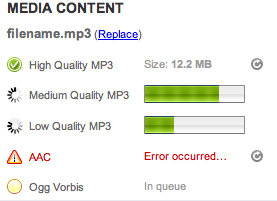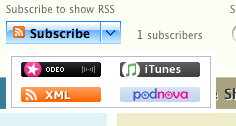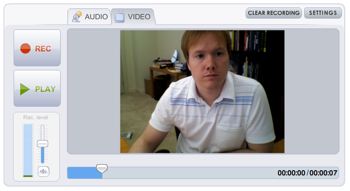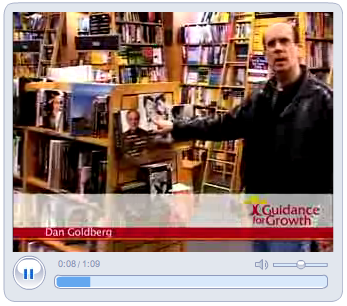
We recently launched our latest project for one of our clients, PodcastPeople, Inc. PodcastPeople is a service that allows anyone to create their own Podcasting show, with detailed tools to track statistics and manage media. We have learned more than we could have imagined about handling media, working in Ruby on Rails, and managing monthly subscriber based processes. It's been a fun project and we are sure that it will serve the industry well.
The best way to explore all of the features is to sign up for a free account, but I would like to showcase some of the features I found the most interesting...
Live Encoding

When uploading media or creating a podcast, it is important to offer many options for media formats. We setup a system utilizing ffmpeg and mencoder that encodes audio and video formats on the fly while the post is edited. These formats are then used for downloads, rss feeds, and the flash player. Building a stable encoding environment consumed a lot of time and effort. It was pretty easy to come up with the concept, but actually getting ffmpeg and mencoder to work consistently with hundreds of shows and limitless types of input media formats was exhausting. As you can see from the screen shot, all encoding progress can be seen in real-time for each file. If an error occurs, it is displayed immediately to the customer.
RSS Feeds and Subscribers

All rss feeds in PodcastPeople are handled automatically, including the ability to choose which formats are used for the feed. For instance, if the majority of your audience are Windows users, you can select the WMV format as the default rss format. We also created specific handling for iTunes feeds, which use the encoded mp4 or mp3 format in all cases.
Subscriber statistics are based on the logic used in Feedburner. By combining unique requests from each reader and parsing the user-agent strings for reader services, we count the subscriber averages over a period of time to calculate the consistent subscriber-base.
Amazon S3
Early on we decided that the use of Amazon S3 would help with bandwidth and content delivery. As part of the encoding process, all media is stored and served from S3. In addition, we also use S3's log files to calculate bandwidth and statistics for media within the system.
Flash Players and Recorder


We built custom flash players for both audio and video on the site. This was neccessary to allow in-page viewing or listening of the media content. When files are encoded, the Flash FLV format and mp3 is used for this purpose. Since many people do not have the proper software or experience to produce and edit audio and video, we also built a browser-based video and audio recorder. This allows anyone with a mic and web cam to record media directly on the site, which is then encoded and used for posting an episode.
The system offers many more features, such as detailed statstics, ad/sponsor management to monetize the show, and the ability to customize the look & feel of the show with themes and widgets (see screen shot below). To learn more I recommend that you check out their site and sign up for a free account.



